
Scilla, known as the squills, is a genus of about 50 to 80 bulb-forming perennial herbaceous plants in the family Asparagaceae, subfamily Scilloideae, native to woodlands, subalpine meadows, and seashores throughout Europe, Africa and the Middle East. A few species are also naturalized in Australia, New Zealand and North America. Their flowers are usually blue, but white, pink, and purple types are known; most flower in early spring, but a few are autumn-flowering. Several Scilla species are valued as ornamental garden plants.
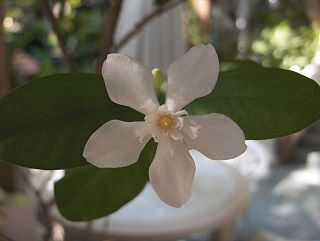
Wrightia is a genus of flowering plants in the family Apocynaceae, first described as a genus in 1810. It native to tropical Africa, China, the Indian Subcontinent, Southeast Asia, Papuasia, and Australia. The species are all small trees or shrubs.

Maclura is a genus of flowering plants in the mulberry family, Moraceae. It includes the inedible Osage orange, which is used as mosquito repellent and grown throughout the United States as a hedging plant.

Echinodorus, commonly known as burhead or Amazon sword, is a genus of plants in the family Alismataceae, native to the Western Hemisphere from the central United States to Argentina. Its scientific name is derived from Ancient Greek echius – "rough husk" - and doros – "leathern bottle" - alluding to ovaries, which in some species are armed with persistent styles, forming prickly head of fruit. Some of the species are commonly cultivated in artificial aquatic habitats.
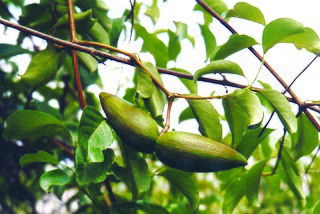
Decalepis hamiltonii is a species of plant in the family Apocynaceae. It is endemic to Peninsular India and known by its names of maredu kommulu, nannari kommulu or madina kommulu in Telugu, makali beru or vagani beru in Kannada and magali kizhangu in Tamil is a plant whose root is used in Ayurvedic medicines and for use in pickles and to make sharbat.

Hemidesmus indicus, Indian sarsaparilla is a species of plant that is found in South Asia. It is a slender, laticiferous, twining, sometimes prostrate or semi-erect shrub. Roots are woody and aromatic. The stem is numerous, slender, terete, thickened at the nodes. The leaves are opposite, short-petioled, very variable, elliptic-oblong to linear-lanceolate. The flowers are greenish outside, purplish inside, crowded in sub-sessile axillary cymes. It occurs over the greater part of India, from the upper Gangetic plain eastwards to Assam and in some places in central, western and South India.

Cyanotis is a genus of mainly perennial plants in the family Commelinaceae, first described in 1825. It is native to Africa, southern Asia, and northern Australia.

Sarcostemma is a genus of flowering plants in the dogbane family, Apocynaceae, first described as a genus in 1810. The name is derived from the Greek words σαρκὸς (sarkos), meaning "flesh," and στέμμα (stemma), meaning "garland". Members of the genus are known generally as climbing milkweeds or caustic bushes. They are found across Africa and tropical Asia, in Australia, and in parts of North America. These plants are perennial flowering shrubs with trailing vines or lianas. They are often adapted to heat and/or desert conditions. Some have few or no leaves and photosynthesize in the tissues of the green stems. The soft stems are filled with a milky white latex that is poisonous and caustic in some species. The flowers have a ring of thick tissue at the base which extends into hollow spherical appendages within the flower corolla.
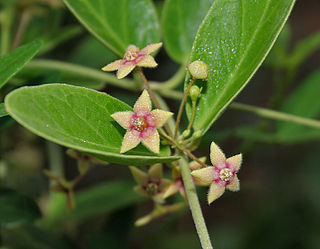
Tylophora is a genus of climbing plant or vine, first described as a genus in 1810. It is native to tropical and subtropical Asia, Africa, and Australia. Most of the species are perennial lianas. The name is derived from the Ancient Greek tylos/τυλος "knot", and phoros/φορος "bearing". The genus was originally erected by Robert Brown for four species he described in Australia. It was placed in the Asclepiadaceae, which has now been sunk into Apocynaceae.

Utricularia scandens is a small, probably annual carnivorous plant that belongs to the genus Utricularia. It has a wide native distribution that includes Africa and Asia. U. scandens grows as a terrestrial plant in wet grasslands and bogs at lower altitudes around sea level up to 2,300 m (7,546 ft). It was originally described by Ludwig Benjamin in 1847. There is a significant amount of synonymy established for this species, in part because of its large distribution and variable morphology.

Gymnema is a genus in the family Apocynaceae first described as a genus in 1810.
Sarsaparilla often refers to the sarsaparilla soft drink, made from Smilax plants.
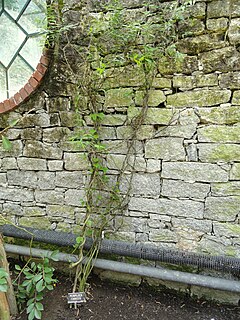
Periploca is a genus of plants in the family Apocynaceae, first described for modern science by Linnaeus in 1753. It is native to Europe, Asia, and Africa.
- Periploca aphyllaDecne. - Middle East from Sinai to Pakistan
- Periploca calophylla(Wight) Falc. - S China, Nepal, Bhutan, Assam, E Himalayas, Vietnam
- Periploca chevalieriBrowicz - Cape Verde Islands
- Periploca chrysanthaD.S. Yao, X.D. Chen & J.W. Ren - Gansu Province in China
- Periploca floribundaTsiang - Yunnan, Vietnam
- Periploca forrestiiSchltr. - Guangxi, Guizhou, Qinghai, Sichuan, Tibet, Yunnan, India, Kashmir, Myanmar, Nepal
- Periploca graecaL. - Mediterranean
- Periploca hydaspidisFalc. - Kashmir
- Periploca laevigataAiton - Canary Islands, Savage Islands
- Periploca linearifoliaQuart.-Dill. & A. Rich - Ethiopia
- Periploca nigrescensAfzel. - W Africa
- Periploca refractifoliaGilli - Tanzania
- Periploca sepiumBunge - widespread across much of China
- Periploca tsiangiiD. Fang & H.Z. Ling - Guangxi Province in China
- Periploca visciformis(Vatke) K. Schum. - Somalia
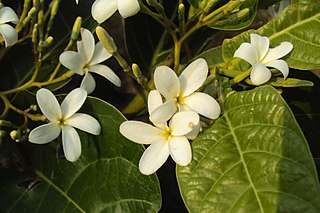
Holarrhena is a genus of plant in the family Apocynaceae first described as a genus in 1810. It is native to tropical and southern Africa as well as south, east, and southeast Asia. As of August 2013 the World Checklist of Selected Plant Families recognises 5 species:
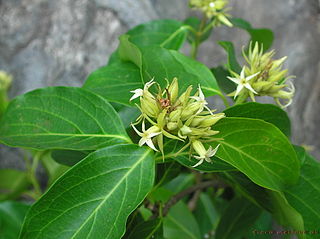
Aganosma is a genus of plants in family Apocynaceae first described as a genus in 1837. It is native to China, the Indian Subcontinent, and Southeast Asia.
- Aganosma brevilobaKerr - Guizhou, Myanmar, Thailand
- Aganosma cymosa(Roxb.) G.Don - Guangxi, Yunnan, Bangladesh, Assam, Sri Lanka, Indochina
- Aganosma gracilisHook.f. - Assam, Bhutan, Arunachal Pradesh
- Aganosma heynei(Spreng.) ined. - India
- Aganosma laceiRaizada - Myanmar
- Aganosma petelotiiLý - N Vietnam
- Aganosma schlechterianaH.Lév. - S China, Assam, N Indochina
- Aganosma siamensisCraib - Thailand, Vietnam, Guangxi, Guizhou, Yunnan
- Aganosma wallichiiG.Don - Myanmar, Thailand, W Malaysia, Java, Sumatra

Periplocoideae is a subfamily of the dogbane plant family, Apocynaceae. It was not divided into tribes as of 2014.
Gongronema is a genus of plants first described as a genus in 1844. Some of the species are native to Africa, with others in South and Southeast Asia.

Orthosia is a genus of plants in the family Apocynaceae, first described as a genus in 1844.
Pentasachme is a species of plants in the Apocynaceae first described as a genus in 1834. It contains only one recognized species, Pentasachme caudatum, native to southern China, the Indian Subcontinent, and Southeast Asia.
Finlaysonia is a genus of flowering plants in the dogbane family Apocynaceae, found from Sri Lanka, India, through Southeast Asia, New Guinea, northern Australia, the Philippines, and Palau. They tend to be vines or climbers and prefer to live on limestone, alongside rivers, or in mangrove swamps.
















